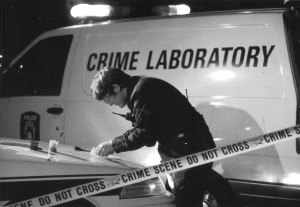When is a Crime Scene Staged?
There are many reasons why a crime scene has been staged. The most difficult task is to recognize some of the subtle appearances to indicate that a crime scene has been indeed staged. Fires are an example of a type of potential staged crime scene; it’s usually to cover up a previous crime that had been committed such as murder or insurance purposes for profit.
Every detective or forensic investigator must use their own objective skills along with experience to determine if a crime scene as been staged. It’s important to preserve all evidence and document everything in proper order. Notes, sketches, and photographs are extremely helpful to help determine staged crime scenes.
These signs from burglary and/or homicide investigations should alert detectives that something is potentially suspicious:
- No sign of a forced entry
- Forced entry is clearly evident
- No search for any valuables is apparent
- No items have been stolen
- Only one particular item has been stolen
- Drawers have been pulled out and dumped to make it look like “ransacked” (out of ordinary) appearance
- Drawers have been pulled out carefully and neatly stacked in order to protect certain items
- Victim had life insurance
- Victim’s death was profitable for family members other than life insurance
To simply illustrate what a staged crime looks like, investigators must look for any evidence that appears like it doesn’t belong.
Points of Entry
This is the most common staged crime scene element, usually an open or broken window. Examine these areas closely and determine whether or not it’s plausible or if there are other trace evidence such as blood, fingerprints, broken glass, etc.
Weapons Left or Removed
A firearm is the most common staged crime scene weapon. Was this weapon left initially? Did it cause the injury? What’s its purpose? Position? Types of injuries?
Movement of Body
One of the least common staged elements is the movement of the body to a secondary crime scene. Examine the clothing, shoes, bloodstains, and hair of the victim to determine if the body has been moved and why. Rigor mortis (stiffening of joints), livor mortis (pooling of blood), blood and trace evidence, along with any type of drag marks can help assist the investigator to determine if the body has been moved.
* * *
Blog: www.authorjenniferchase.com/
Website: www.jenniferchase.vpweb.com/
Crime Watch Blog: www.emilystonecrimewatch.wordpress.com/
Book & Crime Talk: www.blogtalkradio.com/jennifer-chase/
Books: Compulsion = Dead Game = Silent Partner = Screenwriting
Comment
-
Comment by Jennifer Chase on October 18, 2011 at 12:30pm
-
Thanks Ben :)
-
Comment by Benjamin Sobieck on October 18, 2011 at 12:05pm
-
Great post!
Welcome to
CrimeSpace
CrimeSpace Google Search
© 2024 Created by Daniel Hatadi.
Powered by
![]()

You need to be a member of CrimeSpace to add comments!